Environmental engineer Francis de los Reyes works with cutting-edge microbiological techniques to create solutions in the fields of environmental biotechnology and engineering. But his big passion, both professionally and personally, is finding ways to improve the plight of the world’s 2.5 billion people living without adequate sanitation. In this conversation, he tells the TED Blog about his research, his on-the-ground work to improve living conditions in his native Philippines and beyond — and his ongoing fascination with toilets.
You gave a talk at the TED Fellows Retreat on sanitation. What sparked your interest in that?
Because of who I am and where I grew up, in the Philippines, I’ve seen poverty and slums. My career has been about leading-edge environmental engineering — I’ve been trained to design treatment plants that will work for the industrialized world, and to make them cheaper, better, more efficient. But we can’t ignore the billions of people in the developing countries where that’s not going to work. That’s why we have this problem of lack of adequate sanitation. We’ve studied how to design modern wastewater treatment plants, and forgotten the 2.5 billion who don’t have access to clean toilets. We haven’t really properly considered those problems, and invested the required resources. Of course, it’s all related to poverty, but we haven’t really looked carefully enough at what’s happening. There are people who have been working in this area for a long, long time, and I’m just one of them. Slowly, over the years, it’s become a bigger and bigger part of my research. It was very hard to get funding in water and sanitation research for developing countries. Because it’s not sexy, you know? On the other hand, you can argue that research is not the bottleneck, but its implementation on the ground. Or culture, or social context. Well, I think there’s still a lot of room for research, and I think obviously we need to work on implementation and on the social side of things.
Can you describe the situation in the Philippines, and the scope of the problem?
Actually, the situation in the Philippines is not too bad. The United Nations has, as one of its Millennium Development Goals, to cut in half the proportion of people who don’t have access to adequate sanitation and to clean drinking water, by 2015. These goals were set up in 2000. Well, if you look at the numbers, to cut them in half means to change the percentage for drinking water from 35% to 70%, and for sanitation from 25% to 50%. But, even as improvements have been made — if you look at the raw numbers of people still in need, because of population growth — those 2.5 billion people have remained at 2.5 billion, maybe 2.3 billion. The world actually met the MDG for drinking water last year. But for sanitation, we’re not going to make it. So there will still be these billions of people that won’t have toilets. In the Philippines, they’ve actually met the MDGs. Some countries have met the MDGs for water, but not for sanitation, and in sub-Saharan Africa, and some places in Asia, they’re not going to meet either water or sanitation MDGs. Like in India and China, there’s a lot of open defecation — that’s just part of the culture. Lack of infrastructure is a problem too, of course.
So how are you applying your microbiology research to the situation?
We are coming up with alternative ways of thinking about sanitation problems. Right now, our current paradigm is that we collect waste from houses, and we convey them via miles and miles of sewer systems, using freshwater. We’re collecting all this waste, and then we’re treating them all at a centralized treatment plant, millions of gallons per day. That’s what happens in any major city. Some cities have more than one treatment plant — like New York City has 19 to 23 different plants. And then we treat the wastewater, and then we discharge the treated water to a river. The treatment is quite effective. The quality of the effluent that we discharge is actually, in many cases, cleaner and better than the river water.
So the wastewater treatment industry has done a really good job of cleaning our water, and protecting our health. But that’s not happening in developing countries, where the problems are more immediate, like diarrhea. You’ve got to first solve the important problems. Let’s get the pathogens out, let’s kill the stuff that will make children sick. I think we can use these molecular techniques to look at pathogen destruction in some of the technologies used in developing countries. We’ve focused the research on centralized solutions and centralized technologies, but we can also try to optimize decentralized and appropriate solutions.
There was an interesting debate in Mexico. One city decided not to chlorinate the water because there’s a chemical reaction between organic matter and chlorine that forms what we call trihalomethanes, like chloroform. We know that these trihalomethanes are carcinogenic. So basically, if you have dirty water — lots of organic matter, lots of dirt — and if you disinfect that with chlorine, you form these chloroforms. But if you don’t chlorinate, you’re going to have people getting diarrhea. So again, the risk assessment framework should come into play and say, “Hey, let’s put first things first.” We have to sort of be more rational about it. We just can’t apply Western standards to those countries. What we need to do is ask: “What is the relative risk in those situations, and what’s the best place to put our money?”
A clear example of this — NGOs might come into a rural village, and build these nice toilets, right? Made of concrete blocks, nice roof, door, I can lock it, and I put a toilet inside. Well, sometimes they don’t use the toilet. You know what they use the structures for? Storage. It’s the best place in the house — you can lock it, it’s flood-proof, storm-proof, so they put their valuables in there. It’s even better than the house.
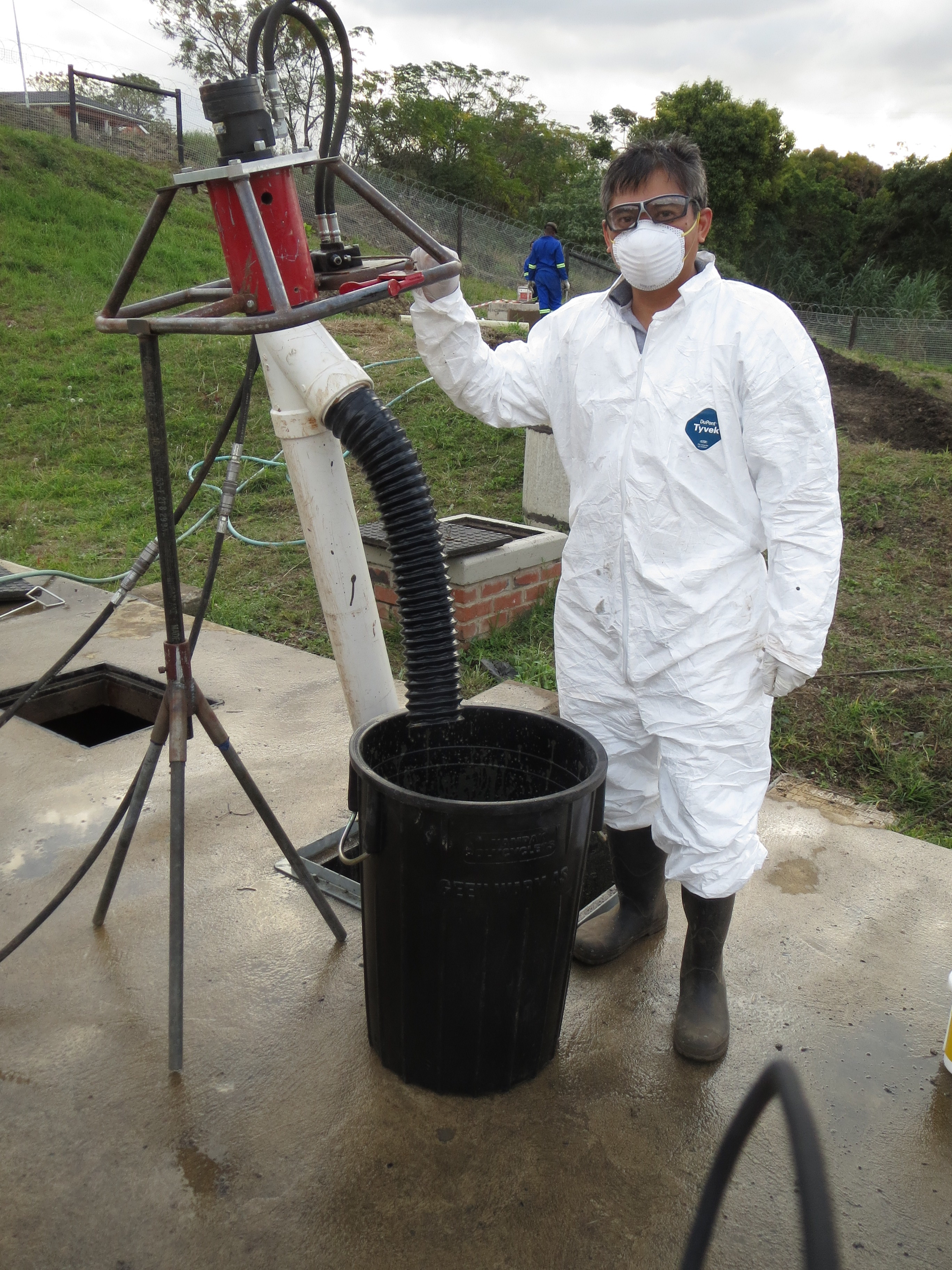
Francis de los Reyes III with “The Excrevator,” the modified power auger designed at North Carolina State University, for emptying pit latrines. The auger was being tested in Durban, South Africa. Photo: Bjorn Pietruschka
Was your background in biology or engineering?
I have a lot of research interests. I did my undergrad in agricultural engineering, and civil engineering for my master’s, but really it was more environmental engineering. For my PhD at Illinois, I did environmental engineering, and that’s where I learned molecular techniques, and microbiology. My dissertation was on using molecular approaches, like DNA and RNA-based methods, to identify and quantify microorganisms in environmental systems. I’m a professor of environmental engineering at NC State, but also associate faculty in microbiology, and also faculty in biotechnology. I straddle the intersection of engineering and microbiology — which is nice, because that’s where things happen.
What does that mean?
Well, traditionally, in microbiology, if you wanted to figure out who’s there in a complex environment, like soils or sludge, it’s difficult. There are hundreds of microbial species in one gram of soil. And there are billions of cells. So the question is: who’s there? In traditional microbiology, what you do is what we call ‘culture-based techniques.’ So you grow them on a plate, with different media. And then you start counting, and whoever grows, grows.
The problem with that approach is — it’s kind of like saying you can see the diversity of animals on Earth by visiting the zoo. But the animals in the zoo are there because they were captured and can live in the zoo under those conditions. They really represent a very tiny fraction of Earth’s actual diversity.
So microbiologists were doing this for hundreds of years. They would count the cells and say, “Okay, those are the cells in this environment.” But we know that’s not true. So we have what’s called the “great plate-count anomaly.” Meaning if I look at my plate counts, and I look under the microscope, I’m orders of magnitude off, because I’m seeing a lot more cells than actually grew.
With molecular techniques, we don’t base it on who grows. We base it on who’s there, based on their genetic signature. In particular, we’re looking at this marker — a molecule called 16S ribosomal RNA gene.
Because the microbes are so small, you can’t see them — but you can detect their DNA chemically?
Yes. It’s hard to distinguish microbes just by looking at them, and for the longest time, we used morphology as a criterion for classifying things. There’s round, we call it cocci; there’s spherical; there’s spiral; there’s vibrio, or comma-shaped; there’s rods, there’s filamentous forms. I can have a bazillion species that look the same. They’re all round — but really, they’re different species. It’s kind of like saying, “Let’s look at people. I can describe them by the hair color, skin color, eye color, the shape of their nose.” You can do that, but you’re not really getting the true picture of who they really are, what’s their genetic makeup, what’s going on inside their bodies.
So in the past couple of decades, researchers started using molecular techniques in microbiology. We now classify organisms according to their molecular signatures. So we have three domains — Bacteria, Archaea, Eukarya. If you look at the phylogenetic tree — the tree of relatedness — humans are just a very, very small portion of it at the very tip of the branches. And the great diversity of this whole thing is really microbial. We say it’s a microbial world. You have 10 times more microbial cells than human cells.
Why is this important for environmental engineering?
All this is important because we want to figure out what microbes are doing what in these “dirty environments,” a mix of thousands and millions of species. What microbes remove nitrogen, or convert organic matter, or produce cellulose, or produce biofuels? It’s important to know who’s there, and what they’re doing, and molecular techniques allow us to do that.
If I know the specific sequence — let’s say it’s the 16S ribosomal RNA gene — then I can design something that will be tagging that particular molecule. So if it’s a DNA target, then I can design the complementary DNA. And then I can tag that complementary primer or probe. That probe I can tag with a fluorescent molecule, let’s say, or a radioactive molecule. And then under the right conditions, it’ll hybridize to that, and I can detect my tag. So, for example, I can make organisms light up using a fluorescent molecule. It’s a technique called fluorescence in situ hybridization. Once I can see and quantify it, I can start thinking about how to manipulate the microbial community.
In the past, we had engineering methods but our knowledge of the processes were cruder; we’d lump them all together as milligrams of total solids per liter, and embedded in that was all the microbial diversity. Now, we are really looking at what organisms are doing what jobs inside these systems. This means we can start designing better systems, and making them more efficient and cheaper.
According to the talk you gave at the TED Fellows Retreat, you have this fascination with toilets. You actually go around on your travels and take pictures of toilets?
Yeah. [laughter]
Why do you do that, and what do you do with that information?
Initially it started because I wanted pictures of toilets from different cultures to show my students, to show how people are different. A picture is easy to grasp: if you show a hole in the ground, and say that’s someone’s toilet — a lot of the students haven’t even even thought about the fact that, in some places in the world, you have to squat. But it’s just fascinating too, right? It’s about differences in infrastructure. I wanted to give them perspective on water and sanitation around the world. I don’t have a fetish or anything. I want to make that clear. [laughter]
But I’ve seen some really interesting toilets. I was in Shanghai, the highest observation deck in the world. You can see basically the whole city, and you’re very high up. Well, I go to the restroom, right? And what they’ve done is they’ve built this floor-to-ceiling glass wall — and that’s where they put the men’s urinals. And so you’re peeing, but you’re looking down on the world. You don’t want to just pull out your camera phone. It’s creepy, you know what I mean? So you’ve got to wait until there’s no one else there, and then take a picture. But it’s like — I’m peeing on top of the world! Look at this!
Recently I was in South Africa, so we went to Cape Point. It’s roughly where the Indian Ocean meets the Atlantic Ocean. It’s not the southernmost tip of Africa, but close enough. So you can hike out to the edge, and I’m thinking oh, I have to pee. So then on the way back, there’s this concrete building that they had sort of built and then abandoned. They’re now part of the landscape, quite organic.
So I’m, “Okay, I’ve got to pee.” So I went, climbed up a bit, and I looked, and I said, “Wow, nobody can see me!” And so I started peeing, and I’m like, “Look at this, there’s the Indian Ocean, there’s the Atlantic Ocean.” And I took a picture. It’s part of a collection of beautiful places I’ve peed.
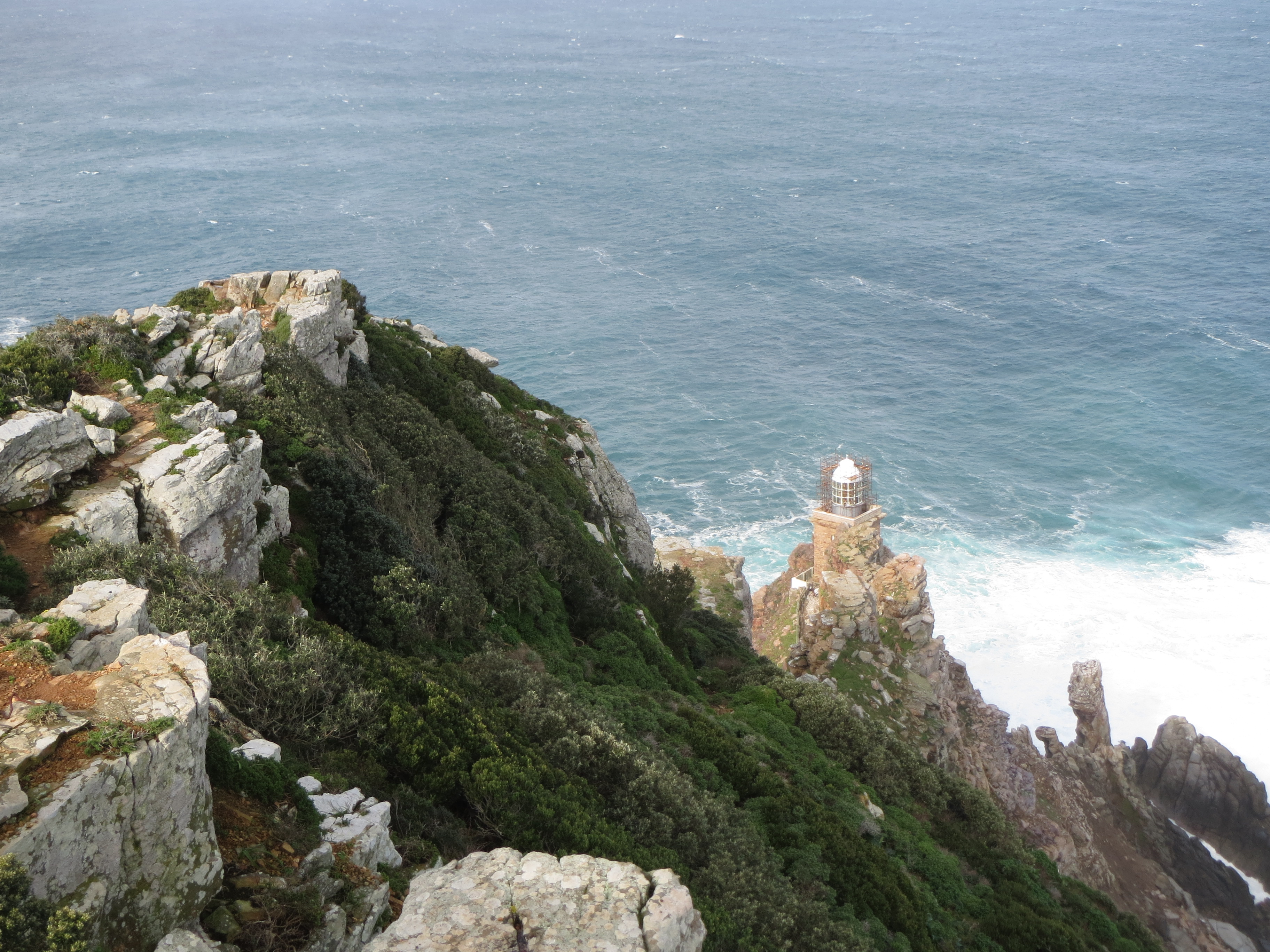
View from the cliff, Cape Point, South Africa. Photo: Francis de los Reyes
Do you think about alternative sanitation systems in your own research, and about applying them in the developing world?
I think about it all the time. Right now I’m trying to study the urine-diverting toilet. To me, it makes a lot of sense, but there are some issues. Instead of one hole, you’ve got two holes. Front and the back. In the front is where the urine is collected. In the back is the fecal material. And the reason you do that is because the urine naturally contains 80% of the nitrogen, and 50% of the phosphorous.
Is there water in this toilet?
No, typically these are dry toilets. In Switzerland, or Germany, they can install these as flush toilets, but you still separate the urine. So it’s kind of like you have two pipes in the house.
Does this require citywide infrastructure?
It can be building by building. And then in the developing world, it can be toilet by toilet. And then you would collect the urine. And that’s where the problem is, because in some situations you have basically peri-urban and rural areas. They’re far apart, they don’t have any local collection. So at UKZN — University of KwaZulu-Natal in South Africa — they’ve done a study of possible incentive programs for people in private households to collect urine. How much money do we have to pay people to bring us fifty liters of urine? After collection it can be diluted for fertilizer.
We incentivize the collection, so basically now it’s got to meet certain criteria because maybe people will just add water to it in order to profit.Right now the urine is taken to a location where bioreactors and chemical reactors separate out the nutrients and do the precipitation. You end up with struvite, which is magnesium ammonium phosphate, a form of fertilizer. Recovering phosphorous is important because we actually have finite phosphorous resources — I think the latest estimates are maybe we have 100 more years of phosphorous supply.
So that’s one approach. In the developed world, you could build separate lines for urine in an apartment building, making it possible to collect urine for the whole building and allowing for an on-site treatment plant. These decentralized systems are not a new concept; for example, in New York, there are a couple of buildings where they treat and recycle their wastewater in the same building.
The photo you showed during your talk, the one of the pit cleaner, was horrific.
That’s an amazing photo. I didn’t take it — it was from the Sustainable Sanitation Alliance. It’s a classic picture, everybody uses that. And I understand when that picture was taken, the photographer, Florian Erzinger, asked, “Do you want me to block out your face?” And the pitworker said, “No, I want people to see the conditions I’m living in.”It’s not normal to be that bold about it, actually. Like in Kibera, Kenya, the pit emptiers have to do it at night, because there’s a certain stigma — they try to avoid people, and they’re looked down upon. And then a lot of the pit emptiers in some of the African countries, they drink a lot of alcohol. It’s not clear if they drink so they can do the work, or to help them cope afterwards. One of our goals is to make pit emptying less risky and try to professionalize it using low-cost technology. For example, with the modified power auger we developed at NC State University, it may be possible to make small pit emptying businesses more profitable, and at the same time eliminate the social stigma associated with emptying pit latrines.
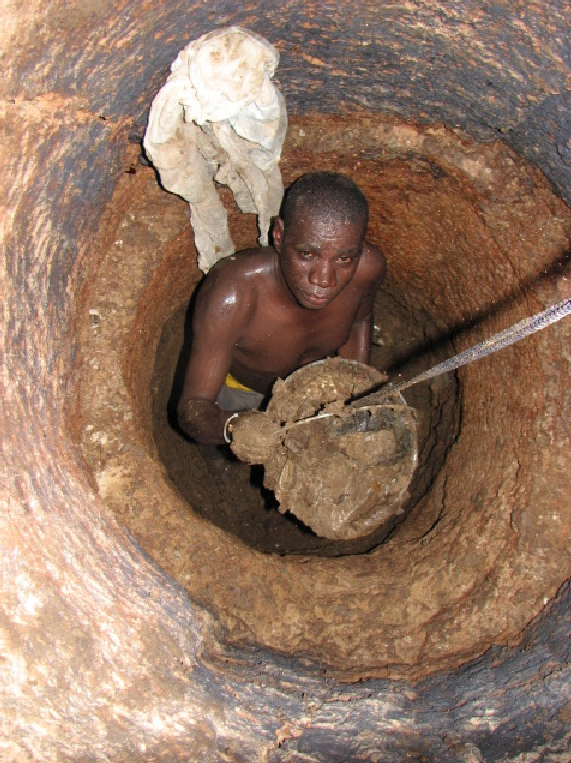
A toilet emptier in Burkina Faso, passing a bucket full of faecal sludge to his assistant. The man works without gloves, boots and mask, because these are too expensive. Photo: Florian Erzinger/Flickr
Do you work for any organizations that promote sanitation?
I work for a Philippines-based NGO called Gawad Kalinga. But it’s not just about toilets — it’s actually converting slums to villages in the Philippines. It’s quite a well-known organization. I’m the area coordinator for North Carolina. There are support organizations all over the world, including the United States.
What we do is raise funds in the US so that local residents can come together and build a whole village, anywhere from 30 to 50 houses at a time. This makes the community come together. Over the thousands of hours put into the houses, people bond as a community. There’s absolutely zero crime afterwards. It’s, “I can’t really be mad at you because you built my house, and you can’t be mad at me because I built your house. And no one knows which house we’re going to get, so we’re all in this together.” So far Gawad Kalinga has built 200,000 houses in the Philippines, and the model is being copied in Papua New Guinea, Cambodia and Indonesia. There’s a GK chapter in Australia, too, serving the aboriginal population.
There’s also an educational aspect to it, because we also build a preschool, and pay for a schoolteacher. Now we’ve got kids from slums going to prestigious colleges in the Philippines, through that program. Each community has a community center, and these offer livelihood programs. If there’s land, then they try to grow food sustainably. For sanitation we build anaerobic baffled reactors, which is on-site wastewater treatment. Technically it’s not enough, but it’s better than nothing, and it’s what the rest of the city is anyway.
So the effluent goes out into the river, and it’s not as clean as you would like?
Exactly.
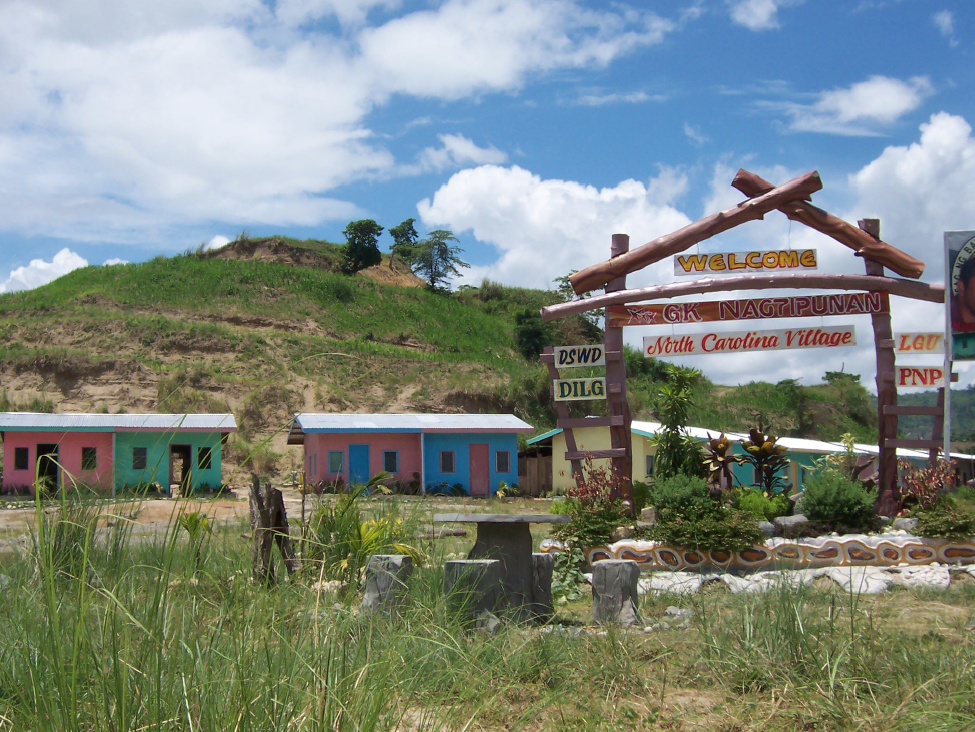
A village built by Gawad Kalinga, funded by Francis de los Reyes’ North Carolina chapter of the organization.
Do you visit sometimes?
Yes, we went to visit the first village we sponsored with my eldest daughter when she was 11. She’s 19 now. This year, we’re raising funds for our Philippine-Americans kids to actually go and build. The problem is so big, we’re not going to be able to fix it in our generation. And so we have to prepare the next generation. There are two things we want to show them. Of course they will see the poverty, the slums. But that’s one half of the equation. You should see the problem, but you should also see also what people are doing to solve it. Because if you only see the problems, you’ll just feel depressed. You’ll be mad — and that’s good, because it gives you the urge to do something. But you’ve also got to see the work that’s happening, because there are some good people doing good work. And I think seeing that would give our kids hope. Because our kids are growing up in Raleigh-Durham, it’s good for them to see this. We’re telling them, “Here’s where I grew up. This is your heritage. It’s part of who you are, and you’ve got to do something about it.”
Besides working with this organization, I’m an adjunct professor at the University of Philippines. I sometimes work for the Philippine government as a scientist, and so I have research projects there at different universities. I hold wastewater treatment workshops, teach treatment plant operators how to operate their systems, too, so in the past 6 years I’ve been going back two times, three times a year.
Do you consider yourself an activist?
I feel like I’ve always been an activist, in college, and high school, because in the Philippines, we had the Marcos dictatorship for 20 years, and we threw him out. During that time, I was part of the activist movement. Then I left the country to go to graduate school. So yes, I’m aware of the brain drain question. It’s the diaspora question, and it’s a valid point. I left when I was 22, half my life ago.
But if I look back, who knows what would have happened if I had stayed? I probably wouldn’t have the same platform — whether social, economic or professional — to do what I’m doing now. Most likely, I would’ve been a university professor there, teaching, but nobody would listen to me. But as a result, I keep going back.
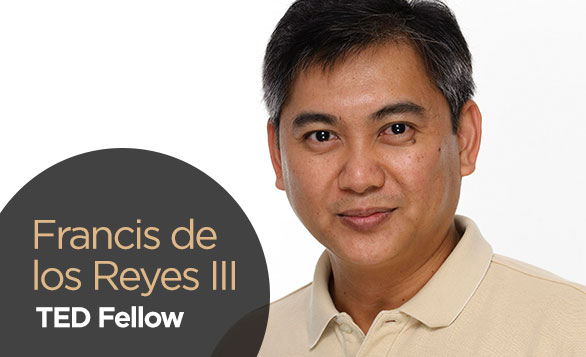
Comments (6)
Pingback: A Scoop + SEO + Digital Media = Big Publication | Plato on-line